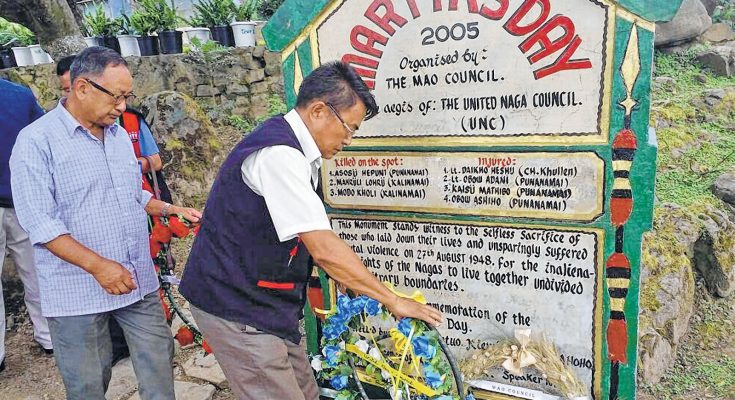 SENAPATI, Aug 27: The 68th Martyrs’ Day was observed at Mao Gate in Senapati district, Ukhrul town and also in Chandel today. The programmes were organised by the respective frontal bodies of the districts under the aegis of the United Naga Council (UNC) to honour Asiisii Hepuni of Punanamei, Mahriili Lohrii and Modo Kholi, both of Kalinamei who were shot dead on the spot and Daikho Hesho of Chowainamai Khullen and Obow Adani of Punanamei who were grieviously wounded and later succumbed to bullet injuries from the indiscriminate firing of Assam Rifles and Manipur police force on August 27, 1948.
SENAPATI, Aug 27: The 68th Martyrs’ Day was observed at Mao Gate in Senapati district, Ukhrul town and also in Chandel today. The programmes were organised by the respective frontal bodies of the districts under the aegis of the United Naga Council (UNC) to honour Asiisii Hepuni of Punanamei, Mahriili Lohrii and Modo Kholi, both of Kalinamei who were shot dead on the spot and Daikho Hesho of Chowainamai Khullen and Obow Adani of Punanamei who were grieviously wounded and later succumbed to bullet injuries from the indiscriminate firing of Assam Rifles and Manipur police force on August 27, 1948.
The Mao Council (MC) organised the event from 11 am. UNC treasurer Kaikho Mao spoke on the occasion at Mao Gate programme. K Kapani, vice president of Mao Council gave the keynote address. Chandel Naga People’s Organisation (CNPO) organised the event in Chandel and Tangkhul Naga Long in Ukhrul, according to UNC. According to a paper issued by the UNC, the observation is to honor those who suffered and made the ultimate sacrifice for the integration of all Nagas over sixty six years ago during the “No-Tax campaign”.
Being a landmark in the history of the political movement of the Nagas in Manipur in particular and all Nagas in general, the observation of “Martyrs’ Day” was taken up by the UNC with the Mao Council as the local organizing committee since August 27, 2005, the UNC added.
The UNC also stated that to the dismay of the Nagas, against their wishes to live together with their brethren of the Naga Hills of then Assam, the Government of India decided to grant a Legislative Assembly in Manipur. At this juncture, Mr FF Pearson, president, Manipur State Darbar hurriedly constituted the Manipur State Constitution and the Manipur State Hill Peoples (Administration) Regulation Drafting Committee to work out an interim administrative arrangement for Manipur before the lapse of the British paramountcy.
“A Daiho and Tiankham, representatives of hill tribes in the Committee pointed out that the draft constitution should incorporate the following clause – “the principle of equality and freedom as applied to all without distinction of caste, creed and race shall include the right of any section of hill people to secede at the end of five years period should the condition within the constitution not be satisfactory”.
“The two made it clear that if the clause was not incorporated they would not be party to the Constitution. When the draft Constitution was submitted to the Maharaja of Manipur on May 5, 1947 FF Pearson, Chairman of the Constitution Drafting Committee, drew the particular and personal attention of the Maharaja to the dissension of the representatives of the hill tribes,” it added.
In spite of the democratic demand for consolidation of contiguous Naga areas under one administrative unit and the explicit opposition to the Manipur State Draft Constitution by the tribe representatives, the general election under the Manipur State Constitution Act 1947 was held in June 1948. The Nagas boycotted the election.
“The “No Tax Campaign” 1948 is a landmark in the history of the political movement of the Nagas of Manipur. Thus the “No Tax Campaign” was launched when Maharaj Kumar Priyobrata Singh was the Chief Minister of Manipur. The Nagas in Manipur refused to pay the annual House Tax to the Government of Manipur and under the aegis of the Naga National League (NNL) submitted their annual house tax to Charles Pawsey, DC of Naga Hills of Assam at Kohima,” the UNC paper also said.
“It was an act of defiance against the authority of the State, under which the Nagas of Manipur had been placed without their consent. It was also a means of putting pressure on the Indian Government for securing the merger of the Nagas in Manipur with the Naga hills district,” the UNC added.
According to the UNC paper, the Manipur Maharaja, Budha Chandra was on good terms with Sir Akbar Hydari, the then Governor of Assam, who was requested by the Maharaja to send a contingent of Assam Rifles to arrest A Daiho.
“Sir Akbar Hydari, well known for his anti Naga political stand, gladly approved and dispatched a contingent of 4 Assam Rifles along with State police equipped with rifles and machine guns, to Mao Gate on August 27, 1948. The Assam Rifles took position in and around Mao Inspection Bungalow in war like fashion and indiscriminately fired at the volunteers/ students of the Mao-Maram Tribal Council (now Mao, Maram, Poumai, Thangal and Upper Zeliang) who were blocking the road leading to the residence of A Daiho”, it added.
The Tangkhul Naga Long (TNL) also observed the day at TNL office Viewland, Ukhrul. TNL president Weapon Zimik said that Nagas have been relentlessly struggling for self determination despite Indian domination after the British left.
The day marks 68 years of struggle for the rights of the Nagas, he said. The Nagas across the State remember the heroic sacrifices for our common cause, he added.



